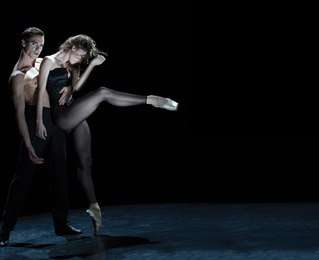|
Back
Retro ‘moderne’ from São Paulo Ottawa
Southam Hall, National Arts Centre
04/26/2016 -
The Seasons
Edouard Lock (choreographer), Gavin Bryars (original music), Ricardo Bologna (music direction), Armand Vaillancourt (set design), Liz Vandal (women’s costume design), Edouard Lock (men’s costume design)
Mamihlapinatapai
Jomar Mesquita (choreographer), Marina de la Riva, Silvio Rodrigues, Rodrigo Leao, Cris Scabello, Cartola and Grupo Planetangos (music), Claudia Schapira (costume design), Joyce Drummond (light design)
Gnawa
Nacho Duato (choreographer), Hassan Hakmoun, Adam Rudolph, Juan Alberto Arteche, Javier Paxarino, Rabih Abou-Khalil, Velez, Kusur e Sarkissian (music), Luis Devota, Modesto Lomba (costumes), Nicolas Fischtel (light design)
São Paulo Companhia de Dança, Inês Bogéa (artistic director)

D. Reca & L. Lopes in The Seasons (© Edouard Lock)
The São Paulo Companhia de Dança made its Canadian debut at Ottawa’s National Arts Centre this week. Founded in 2008 the company arrived with much advance ballyhoo and sufficiently aggressive public relations to generate a near sell-out house at Southam Hall. The performance, for sure, was interesting and often intense, mainly due to the consistently fine work of the troupe’s dancers. The company’s programming however is not as cutting edge as might have been imagined – indeed, major chunks of their current repertoire would have been trendy in the late 1960s or early to mid-1970s.
The opening work, The Seasons was created by the Moroccan-born, Canadian choreographer Edouard Lock (who also designed the men’s costumes). Lasting about fifty minutes, The Seasons puts dancers in groups, trios and pairs through a series of elaborate sequences minimally lit by spots, sometimes from behind, which means the dancers (even when doing dramatic circular kicks or frenetically elaborate arm work) are not the visual focus. Rather, the patterns created by what this approach permits audiences to see become the focus. The effect suggests swirling paint brushes in action and is initially striking. This might work brilliantly as a Divertissement item for an avant-garde staging of Swan Lake or The Sleeping Beauty – the bluebirds or the cats – but it wears then when stretched to almost an hour.
The music by Gavin Bryars (with apologies to Vivaldi) is an electronic string ensemble so grating it might be homage to late performances by Yehudi Menuhin on an off night. Parts of the work are performed during silences which, unfortunately, come across as sonic dead spots, and the pauses seem random. As The Seasons continued, it might have ended during any of several such places, but plodded along nonetheless with little genuine drama or tension. When the work did finish, the reaction was polite applause and definitely not the standing ovation Ottawa dance lovers tend to hand out fairly generously.
After intermission, Jomar Mesquita’s Mamihlapinatapai concerned the desire for love between men and women, as the program note informed us. It begins quietly with what may be pop music from a distant radio playing (five composers are credited). Soon we’re back to groups and pairs of dancers performing in mainly ballroom style to a kind of Mediterranean miscellaneous pop score. Some dancers wear hot reds and the overall impression is a production Les Grands Ballets Canadiens might have done fifty years ago. (Edouard Lock, it may be noted, once danced with Les Grands Ballets.) The work is entertaining in an obvious ‘showbiz’ fashion, though dim lighting as well as lack of originality seemed to prevent viewers from becoming strongly engaged and, again, the response was only polite applause.
Following a pause, during which a couple of dozen audience members took their leave, we reached Gnawa, by choreographer Nacho Duato. Finally, things were more interesting and we witnessed a work which genuinely aimed for something original. Said to evoke the nature of Valencia (about halfway down Spain’s east coast), Gnawa’s Mediterranean ambience seemed more Moroccan and Arabic than Spanish, though such overlap is to be expected. The music (again, a group effort) ranged from low register electronic percussion suggesting a heartbeat through Paul Horn inspired 1980s new age quotes to a possible snake charmer. The women are dressed mainly in black and the men are topless and wear tight cream pants, while the dancing overall is more conventionally balletic. Lighting was brighter than for the earlier works and the dancers were able to shine, which the audience clearly appreciated. Finally, the company got its standing ovation.
If the São Paulo Companhia de Dança isn’t quite the revelation we were led to expect, it’s a solid company with tremendous dancers, and with an admirable commitment to developing choreographic talent from both established and newer ranks. It should be interesting to see them again in a few more years.
Charles Pope Jr.
|